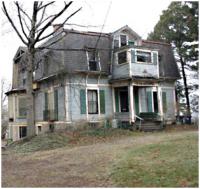November 27, 2013
 24 Grampian Way: Landmarks Commission voted unanimously to make it a city landmark on Tuesday.
24 Grampian Way: Landmarks Commission voted unanimously to make it a city landmark on Tuesday.
The Boston Landmarks Commission on Tuesday voted 9-0 to designate a controversial Savin Hill property as a city landmark.
The commission agreed that the home, located at 24 Grampian Way, is significant at the national, state and local level, in large part due to its association with George Wright, a national sports figure, according to Ellen Lipsey, executive director of the commission. Wright, a member of the Cincinnati Red Stockings, was inducted into the Baseball Hall of Fame in the 1930s. The municipal golf course in Hyde Park is named after him.
The home, also known as the Kehew-Wright house, is also associated with whale oil merchant John Kehew and industrialist William Prescott Hunt.
Mayor Thomas Menino will have 15 days to approve the designation or express his disapproval in writing. If he approves the designation, it is sent to the City Council, which will have 30 days to consider the designation.
The 13-member council can override the designation through a two-thirds vote. The commission’s designation is rarely overturned.
The family of the late Ray Tomasini is seeking a permit to tear down the deserted structure, and has lobbied city councillors on the matter. The family and other opponents of a landmark designation argue that the designation would make the property harder to sell and redevelop. The Tomasini estate sought— and won— city approval to raze an adjacent stable. The structure was demolished in October— much to the chagrin of preservationists who wanted it saved as well.
District 3 Councillor Frank Baker, who lives down the street from the home, also voiced opposition to the designation, but withdrew his comments after questions were raised about whether the comments represented a conflict of interest.
The landmark designation was supported by the commission’s staff and the Dorchester Historical Society.
“While the house is not an extraordinary example of its type, it represents a high style house on a large lot for a prosperous upper middle class family,” the commission said in a response this month to public comments on the home. “At the time of its construction, the Second Empire style of architecture was very fashionable. The exterior ornamentation that has remained intact, such as the pierced rickrack edging and stick-style cross bracing, shows the builder’s attention to detail. While it is true that additions and alterations have been made over the years according to the tastes and needs of the various occupants, they have not detracted from the original form and massing of the building.”
Villages:
Topics:


